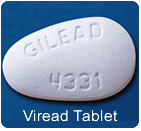Effectiveness
and Safety of Tenofovir in Real-world Clinical Practice
 |
 |
 |
 |
 |
|
| SUMMARY:
Tenofovir (Viread)
produced good hepatitis B virus (HBV) suppression in both
nucleoside/nucleotide-naive and treatment-experienced patients
in routine clinical practice, indicating that clinical trial
outcomes extend to real life, according to findings presented
the recent American Association for the Study of Liver Diseases
"Liver Meeting" (AASLD 2010)
in Boston. Furthermore, most tenofovir recipients did not
show evidence of kidney toxicity, even in the absence of formal
screening and exclusion of at-risk patients. |
|
|
 |
 |
 |
 |
By
Liz Highleyman
 Pietro
Lampertico from Universita degli Studi di Milano and colleagues conducted
a retrospective/prospective cohort study that enrolled 737 chronic hepatitis
B patients starting tenofovir
at 17 centers in Italy. Pietro
Lampertico from Universita degli Studi di Milano and colleagues conducted
a retrospective/prospective cohort study that enrolled 737 chronic hepatitis
B patients starting tenofovir
at 17 centers in Italy.
Three-quarters were men, the median age was 56 years, and 77% were hepatitis
B "e" antigen (HBeAg) negative. Individuals with HIV coinfection
were excluded. About 40% had liver cirrhosis and 9% had hepatocellular
carcinoma.
Participants could be on either tenofovir monotherapy (27%) or combination
therapy (72%), mostly with lamivudine
(Epivir-HBV). Nearly one-third (30%) had received prior interferon
treatment and 71% had previously used nucleoside/nucleotide analogs
or showed resistance to these drugs; the remaining 29% were nucleoside/nucleotide-naive.
14% of patients started on a lower tenofovir dose due to reduced creatinine
clearance, a sign of impaired kidney function.
Patients were followed for a median of 16 months (range 0-52 months).
The researchers measured HBV DNA viral load and looked for adverse events,
focusing on kidney dysfunction, since tenofovir is known to cause kidney
impairment in a small proportion of patients.
Results
 |
Among
nucleoside/nucleotide-naive patients (median baseline viral load
of 5.9 log IU/mL), rates of virological response, or undetectable
HBV DNA, were as follows: |
| |
 |
12
weeks: 37%; |
 |
24
weeks: 66%; |
 |
36
weeks: 72%; |
 |
48
weeks: 89%. |
|
 |
The
time it took to achieve undetectable HBV was significantly affected
by baseline viral load. |
 |
At
48 weeks, 17 patients had only a partial virological response, with
a median 2.5 log IU/mL residual viremia. |
 |
Among
nucleoside/nucleotide-experienced or resistant patients, viral load
remained undetectable in those who switched from adefovir (Hepsera)
to tenofovir. |
 |
HBV
DNA became undetectable in 74% of patients with ongoing HBV replication
due to resistance at baseline (median HBV DNA 4.1 log IU/mL), independent
of treatment strategy. |
 |
In
a pooled safety assessment, 3% of patients had a serum creatinine
increases greater than 0.3 mg/dL, and < 1% had increases greater
than 0.5 mg/dL, compared with baseline levels. |
 |
8%
of patients saw their blood phosphorus level fall below 2.3 mg/dL,
another sign of kidney impairment. |
 |
37%
had their urinary phosphate absorption (as assessed by estimated
TmPI/GFR) decrease below 0.7 mmol/L. |
 |
Most
of these patients, however, had long-term previous exposure to adefovir,
which can also cause kidney dysfunction. |
 |
6%
of patients reduced their tenofovir dose due to worsened creatinine
clearance. |
 |
Most
patients in this group were older than 60 years, had previous exposure
to adefovir, were taking other potentially nephrotoxic (kidnet toxic)
medications, and/or had other conditions associated with poor kidney
function. |
"Tenofovir
suppressed HBV replication in most [nucleoside/nucleotide]-naive and
[nucleoside/nucleotide]-experienced or resistant patients in field practice,"
the investigators concluded. "Few patients showed an impaired renal
and tubular function of multifactorial origin."
Investigator affiliations: 1st Division of Gastroenterology, Fondazione
IRCCS Ca' Granda Ospedale Maggiore Policlinico, Università degli
Studi di Milano, Milano, Italy; Gastroenterology Division, University
of Ankara Medical School, Ankara, Turkey; Hospital General Universitario
Valle Hberon and Ciberehd, Barcelona, Spain; 2nd Dept. of Internal Medicine,
Hippokration Hospital, Athens, Athens, Greece; SC Epatologia e Gastroenterologia,
Ospedale Niguarda Cà Granda, Milano, Italy; Servizio Malattie
Epatiche e Infettive, Humanitas Gavazzeni, Bergamo, Italy; UO Epatologia,
Ospedale di Treviglio, Treviglio, Italy; S.C. Medicina Generale, Ospedale
A. Manzoni, Lecco, Italy; Gastroenterology Unit, Liver and Lung Transplantation
Center, Ospedali Riuniti di Bergamo, Bergamo, Italy; Unita Operativa
di Medicina, Servizio di Epatologia, Ospedale Sant' Anna, Como, Italy;
Unita Operativa di Gastroenterologia, Fondazione Poliambulanza, Ospedale
S.Orsola, Brescia, Italy; Clinic of Infectious Diseases, Universita
di Foggia, Foggia, Italy; I and II Div. Infectious Diseases, Ospedale
Luigi Sacco, Milano, Italy; Liver Center, Clinica Medica, Azienda Ospedaliera
S. Gerardo, Università Milano Bicocca, Monza, Italy; UO Gastroenterologia,
Ospedale Valduce, Como, Italy; Infectious Diseases, Ospedali Riuniti
di Bergamo, Begamo, Italy.
11/23/10
Reference
P Lampertico, M Vigano, C Yurdaydin, and others. Effectiveness and
safety of Tenofovir disoproxil fumarate in field practice: a multicenter
European cohort study of 737 patients with chronic hepatitis B. 61st
Annual Meeting of the American Association for the Study of Liver Diseases
(AASLD 2010). Boston, October 29-November 2, 2010. Abstract
369.
|
|